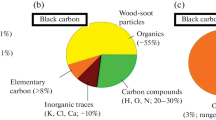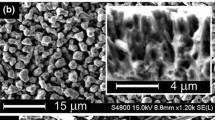Abstract
The imbibition process into the pore structure of highly porous nanoparticle layers is investigated. The layers are fabricated with the Flame-Spray-Pyrolysis process and consist of aggregated \(\hbox {TiO}_{2}\) nanoparticles. Measurements of the pore structure reveal that these layers have a very high porosity and a broad pore size distribution. Imbibition experiments show a deviation of the imbibition process from the classical capillary rising theory (Bell, Cameron, Lucas and Washburn). Therefore, a new capillary rising model is developed that accounts for the complex pore structure within layers of aggregated particles through the implementation of the fractal dimension of tortuosity. Comparison of the new model and the performed imbibition experiments enable the determination of the equivalent pore diameter for the imbibition process. The resulting pore diameter agrees well with the mean pore diameter of the nitrogen physisorption measurements. Hence, the new model enables the prediction of the imbibition process into highly porous layers of aggregated particles.









Similar content being viewed by others
Abbreviations
- a :
-
Factor of the power law fitting (\(\hbox {m}^{1+{b}}\,\hbox {s}^{-1}\))
- A :
-
Cross-sectional area of the porous medium (\(\hbox {m}^{2}\))
- \({A}_\mathrm{p}\) :
-
Cross-sectional area of a pore (\(\hbox {m}^{2}\))
- b :
-
Exponent of the power law fitting (–)
- BET:
-
Brunauer–Emmett–Teller
- BJH:
-
Barret–Joyner–Halenda
- BCLW:
-
Bell, Cameron, Lucas and Washburn
- Bo :
-
Bond number (–)
- \({c}_{\mathrm{KC}}\) :
-
Kozeny–Carman constant (–)
- \({c}_{\mathrm{Ar}}\) :
-
Archie constant (–)
- \({c}_{0}\) :
-
Factor of the capillary rising model (\(\hbox {m}^{2}\,\hbox {s}^{-1}\))
- \({d}_\mathrm{p}\) :
-
Pore diameter (m)
- \(\Delta {d}_\mathrm{p}\) :
-
Pore diameter interval (m)
- \({d}_{\mathrm{p,eq}}\) :
-
Equivalent pore diameter for the imbibition process (m)
- \({\bar{d}}_{\mathrm{p,2}}\) :
-
Weighted mean pore diameter of the \({q}_{2}\) (\({d}_\mathrm{p}\)) distribution (m)
- \({d}_{\mathrm{32,pa}}\) :
-
Sauter mean diameter of the primary particles (m)
- \({D}_\mathrm{t}\) :
-
Fractal dimension of tortuosity (–)
- FSP:
-
Flame-Spray-Pyrolysis
- g :
-
Gravitational constant (\(\hbox {m}^{2}\,\hbox {s}^{-1}\))
- \({L}_{0}\) :
-
Straight-line flow length (m)
- \({L}_\mathrm{p}\) :
-
Flow length inside the pore (m)
- \({F}_{\mathrm{fr}}\) :
-
Friction force (N)
- \({F}_{\mathrm{cap}}\) :
-
Capillary force (N)
- \({F}_{\mathrm{gra}}\) :
-
Gravitational force (N)
- m :
-
Time exponent (–)
- \({N}_\mathrm{p}\) :
-
Number of pores (–)
- p :
-
Pressure (Pa)
- \({p}_{\mathrm{cap}}\) :
-
Capillary pressure (Pa)
- \({p}_{\mathrm{gra}}\) :
-
Gravitational pressure (Pa)
- \({p}_{\mathrm{lam}}\) :
-
Lamination pressure (Pa)
- \({q}_{0}(d_\mathrm{p})\) :
-
Differential pore number distribution (\(\hbox {m}^{-1}\))
- \({q}_{2}(d_\mathrm{p})\) :
-
Differential pore area distribution (\(\hbox {m}^{-1}\))
- s :
-
Standard deviation (a.u.)
- \({S}_\mathrm{p}\) :
-
Surface area of the pore (\(\hbox {m}^{2}\))
- \({S}_{\mathrm{pa}}\) :
-
Surface area of the particles (\(\hbox {m}^{2}\))
- SEM:
-
Scanning-electron-microscope
- \(\hbox {SSA}_{\mathrm{fil}}\) :
-
Specific surface area of the filter paper (\(\hbox {m}^{2}\,\hbox {g}^{-1}\))
- \(\hbox {SSA}_{\mathrm{sam}}\) :
-
Specific surface area of the sample (\(\hbox {m}^{2}\,\hbox {g}^{-1}\))
- \(\hbox {SSA}_{\mathrm{pa}}\) :
-
Specific surface area of the nanoparticles (\(\hbox {m}^{2}\,\hbox {g}^{-1}\))
- \({t}_{n}\) :
-
Time step n (s)
- \({v}_{0}\) :
-
Straight-line imbibition velocity (\(\hbox {m}\,\hbox {s}^{-1}\))
- \(v_\mathrm{p}\) :
-
Specific pore volume (\(\hbox {m}^{3}\,\hbox {g}^{-1}\))
- \(\Delta v_\mathrm{p}\) :
-
Differential specific pore volume (\(\hbox {m}^{3}\,\hbox {g}^{-1}\))
- \({V}_\mathrm{p}\) :
-
Pore volume (\(\hbox {m}^{3}\))
- \({V}_{\mathrm{pa}}\) :
-
Particle volume (\(\hbox {m}^{3}\))
- \({\dot{V}}\) :
-
Volume flow rate (\(\hbox {m}^{3}\,\hbox {s}^{-1}\))
- \(\dot{V}_{i}\) :
-
Volume flow rate in a pore (\(\hbox {m}^{3}\,\hbox {s}^{-1}\))
- \({w}_{\mathrm{fil}}\) :
-
Mass fraction of the filter paper (–)
- XRD:
-
X-ray diffraction
- \(\alpha \) :
-
Statistical significance level (–)
- \(\beta \) :
-
Geometry correction factor for the pore diameter (–)
- \(\varepsilon \) :
-
Longest non-tortuous flow length (m)
- \(\eta _\mathrm{l}\) :
-
Viscosity of the liquid (Pa s)
- \(\theta _{\mathrm{adv}}\) :
-
Advancing contact angle (\({^{\circ }}\))
- \(\kappa \) :
-
Electrical conductivity (\(\hbox {S}\,\hbox {m}^{-1}\))
- \(\rho _\mathrm{l}\) :
-
Density of the liquid (\(\hbox {kg}\,\hbox {m}^{-3}\))
- \(\sigma _\mathrm{l}\) :
-
Surface tension of the liquid (\(\hbox {N}\,\hbox {m}^{-1}\))
- \(\tau \) :
-
Tortuosity (–)
- \(\phi \) :
-
Porosity (–)
- \(\psi \) :
-
Orientation angle to a horizontal plane (\({^{\circ }}\))
References
Alava, M., Dubé, M., Rost, M.: Imbibition in disordered media. Adv. Phys. 53(2), 83–175 (2004)
Archie, G.E.: The electrical resistivity log as an aid in determining some reservoir characteristics. Trans. Am. Inst. Min. Metall. Pet. Eng. 146, 54–61 (1942)
Barrett, E.P., Joyner, L.G., Halenda, P.P.: The determination of pore volume and area distributions in porous substances. 1. Computations from nitrogen isotherms. J. Am. Chem. Soc. 73(1), 373–380 (1951)
Bell, J.M., Cameron, F.K.: The flow of liquids through capillary spaces. J. Phys. Chem. 10(8), 658–674 (1905)
Bortz, J., Schuster, C.: Statistik für Human- und Sozialwissenschaftler, 7th edn. Springer, Berlin (2010)
Brunauer, S., Emmett, P.H., Teller, E.: Adsorption of gases in multimolecular layers. J. Am. Chem. Soc. 60, 309–319 (1938)
Butt, H.-J., Kappl, M.: Surface and Interfacial Forces. Wiley-VCH, Weinheim (2010)
Cai, J.C., Yu, B.M.: A discussion of the effect of tortuosity on the capillary imbibition in porous media. Transp. Porous Media 89(2), 251–263 (2011)
Cai, J.C., Yu, B.M., Zou, M.Q., Luo, L.: Fractal characterization of spontaneous co-current imbibition in porous media. Energy Fuels 24, 1860–1867 (2010)
Cai, J.C., Hu, X.Y., Standnes, D.C., You, L.J.: An analytical model for spontaneous imbibition in fractal porous media including gravity. Colloids Surf. A 414, 228–233 (2012)
Cai, J.C., Perfect, E., Cheng, C.L., Hu, X.Y.: Generalized modeling of spontaneous imbibition based on Hagen–Poiseuille flow in tortuous capillaries with variably shaped apertures. Langmuir 30(18), 5142–5151 (2014)
Carman, P.C.: Fluid flow through granular beds. Trans. Inst. Chem. Eng. 15, 150–166 (1937)
Chibowski, E.: Solid surface free energy components determination by the thin-layer wicking technique. J. Adhes. Sci. Technol. 6(9), 1069–1090 (1992)
Chibowski, E., González-Caballero, F.: Theory and practice of thin-layer wicking. Langmuir 9(1), 330–340 (1993)
Cui, Z.G., Binks, B.P., Clint, J.H.: Determination of contact angles on microporous particles using the thin-layer wicking technique. Langmuir 21(18), 8319–8325 (2005)
de Boer, J.H., Lippens, B.C., Linsen, B.G., Broekhoff, J.C.P., van den Heuvel, A., Osinga, T.J.: The t-curve of multimolecular \(N_{2}\)-adsorption. J. Colloid Interface Sci. 21(4), 405–414 (1966)
Denesuk, M., Smith, G.L., Zelinski, B.J.J., Kreidl, N.J., Uhlmann, D.R.: Capillary penetration of liquid droplets into porous materials. J. Colloid Interface Sci. 158(1), 114–120 (1993)
Ergun, S.: Fluid flow through packed columns. Chem. Eng. Prog. 48(2), 89–94 (1952)
Fisher, R.A.: On a distribution yielding the error functions of several well known statistics. In: Proceedings of the International Congress of Mathematics, Toronto, pp. 805–813 (1924)
Fisher, R.A.: Statistical Methods for Research Workers, vol. 5. Oliver and Boyd, Edinburgh (1934)
Gelhar, L.W., Mantoglou, A., Welty, C., Rehfeld, K.R.: A Review of Field-scale Physical Solute Transport Processes in Saturated and Unsaturated Porous Media. Electrical Power Research Institute, Palo Alto (1985)
Israelachvili, J.N.: Intermolecular and Surface Forces, 3rd edn. Academic Press, San Diego (2011)
Khattab, I.S., Bandarkar, F., Fakhree, M.A.A., Jouyban, A.: Density, viscosity, and surface tension of water + ethanol mixtures from 293 to 323 K. Korean J. Chem. Eng. 29(6), 812–817 (2012)
Kozeny, J.: Über kapillare Leitung des Wassers im Boden (Aufstieg, Versickerung u. Anwendung auf die Bewässerg). Sitzungsber. Akad. Wiss. Mat. Nat. Kl. Abt. 2a 136 (2a)(5–6), 271–306 (1927)
Lago, M., Araujo, M.: Capillary rise in porous media. J. Colloid Interface Sci. 234(1), 35–43 (2001)
Lemmon, E.W., McLinden, M.O., Friend, D.G.: Thermophysical properties of fluid systems. In: Linstrom, J., Mallard, W.G. (eds.) NIST Chemistry WebBook, NIST Standard Reference Database Number 69. National Institute of Standards and Technology, Gaithersburg (retrieved Apr 2016)
Li, K.W., Horne, R.N.: Characterization of spontaneous water imbibition into gas-saturated rocks. SPE J. 6(4), 375–384 (2001)
Li, K.W., Zhao, H.Y.: Fractal prediction model of spontaneous imbibition rate. Transp. Porous Media 91(2), 363–376 (2012)
Lucas, R.: Über das Zeitgesetz des kapillaren Aufstiegs von Flüssigkeiten. Kolloid-Zeitschrift 23(1), 15–22 (1918)
Mädler, L., Kammler, H.K., Mueller, R., Pratsinis, S.E.: Controlled synthesis of nanostructured particles by flame spray pyrolysis. J. Aerosol Sci. 33(2), 369–389 (2002)
Mädler, L., Roessler, A., Pratsinis, S.E., Sahm, T., Gurlo, A., Barsan, N., Weimar, U.: Direct formation of highly porous gas sensing films by in situ thermophoretic deposition of flame made \(Pt/SnO_{2}\) nanoparticles. Sens. Actuators B 114(1), 283–295 (2006)
Matyka, M., Khalili, A., Koza, Z.: Tortuosity–porosity relation in porous media flow. Phys. Rev. E 78(2), 026306 (2008)
McCabe, W.L., Smith, J.C., Harriott, P.: Unit Operations of Chemical Engineering, 7th edn. McGraw-Hill Chemical Engineering Series, New York (2005)
Morrow, N.R., Mason, G.: Recovery of oil by spontaneous imbibition. Curr. Opin. Colloid Interface Sci. 6(4), 321–337 (2001)
Mueller, R., Kammler, H.K., Wegner, K., Pratsinis, S.E.: OH surface density of SiO\(_2\) and TiO\(_2\) by thermogravimetric analysis. Langmuir 19(1), 160–165 (2003)
Nowak, E., Combes, G., Stitt, E.H., Pacek, A.W.: A comparison of contact angle measurement techniques applied to highly porous catalyst supports. Powder Technol. 233, 52–64 (2013)
Schopf, S.O., Salameh, S., Mädler, L.: Transfer of highly porous nanoparticle layers to various substrates through mechanical compression. Nanoscale 5(9), 3764–3772 (2013)
Student: The probable error of a mean. Biometrika 6, 1–25 (1908)
Teoh, W.Y., Amal, R., Mädler, L.: Flame spray pyrolysis: an enabling technology for nanoparticles design and fabrication. Nanoscale 2(8), 1324–1347 (2010)
Tuller, M., Or, D., Dudley, L.M.: Adsorption and capillary condensation in porous media: liquid retention and interfacial configurations in angular pores. Water Resour. Res. 35(7), 1949–1964 (1999)
van Honschoten, J.W., Brunets, N., Tas, N.R.: Capillarity at the nanoscale. Chem. Soc. Rev. 39(3), 1096–1114 (2010)
Van Oss, C.J., Giese, R.F., Li, Z., Murphy, K., Norris, J., Chaudhury, M.K., Good, R.J.: Determination of contact angles and pore sizes of porous media by column and thin layer wicking. J. Adhes. Sci. Technol. 6(4), 413–428 (1992)
Wang, R., Hashimoto, K., Fujishima, A., Chikuni, M., Kojima, E., Kitamura, A., Shimohigoshi, M., Watanabe, T.: Light-induced amphiphilic surfaces. Nature 388(6641), 431–432 (1997)
Wang, R., Sakai, N., Fujishima, A., Watanabe, T., Hashimoto, K.: Studies of surface wettability conversion on TiO\(_{2}\) single-crystal surfaces. J. Phys. Chem. B 103(12), 2188–2194 (1999)
Washburn, E.W.: The dynamics of capillary flow. Phys. Rev. 17(3), 273–283 (1921)
Wheatcraft, S.W., Tyler, S.W.: An explanation of scale-dependent dispersivity in heterogeneous aquifers using concepts of fractal geometry. Water Resour. Res. 24(4), 566–578 (1988)
Yu, B.M., Cheng, P.: A fractal permeability model for bi-dispersed porous media. Int. J. Heat Mass Transf. 45(14), 2983–2993 (2002)
Yu, B.M., Li, H.M.: A geometry model for tortuosity of flow path in porous media. Chin. Phys. Lett. 21(8), 1569–1571 (2004)
Zhang, H., Popp, M., Hartwig, A., Mädler, L.: Synthesis of polymer/inorganic nanocomposite films using highly porous inorganic scaffolds. Nanoscale 4(7), 2326–2332 (2012)
Acknowledgements
We thank the Deutsche Forschungsgemeinschaft (DFG) for founding this work through the project “Experimental and computational analysis of the forces acting on highly porous nanoparticle scaffolds/layers during liquid imbibition” (MA3333/10-1, HA2420/16-1). We also thank the group of Prof. M. Dreyer from the Center of Applied Space Technology and Microgravity (ZARM) at the University of Bremen, especially P. Prengel, for the surface tension measurements.
Author information
Authors and Affiliations
Corresponding author
Electronic supplementary material
Below is the link to the electronic supplementary material.
Rights and permissions
About this article
Cite this article
Schopf, S.O., Hartwig, A., Fritsching, U. et al. Imbibition into Highly Porous Layers of Aggregated Particles. Transp Porous Med 119, 119–141 (2017). https://doi.org/10.1007/s11242-017-0876-2
Received:
Accepted:
Published:
Issue Date:
DOI: https://doi.org/10.1007/s11242-017-0876-2




